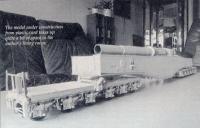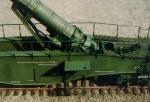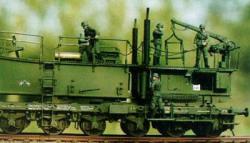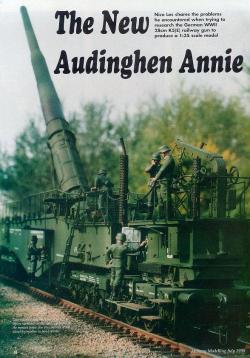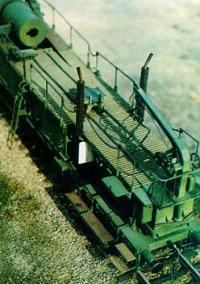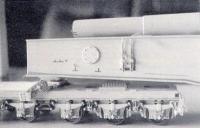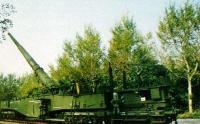|
About three years ago, I acquired the 1:72 scale plastic
kit of the 28cm railway-gun Leopold from Hasegawa. Also known as 'Anzio Annie', its German
designation if 'K5(E)'. K5 is a code name for the gun and (E) stands for Eisenbahn
(railway). Immediately on examining the 1:72 scale Hasegawa kit I wanted to build a larger
scale model of this gun in 1:35 scale, however, there wasn't a kit of it in that scale, at
that time, so I decided to scratch build one.
I made several photographic negatives of parts in the Hasegawa kit and enlarged them to
1:35 scale which saved me a lot of time measuring, but it soon became clear that these
pictures showed a great lack of detail, a problem for anyone wishing to build a larger
scale model. A trip to Aberdeen in the USA to visit the one and only K5 there was
impossible. By sheer coincidence I discovered a new Waffen-Revue magazine (number
89) in a kiosk with a K5 railway gun on its cover. The article in the magazine revealed it
had been found behind an artillery workshop in the south of France, in a town called
Tarbes, where it had stood since the end of W.W.II, rusty and forgotten. A story about
this gun can also be found in After the Battle, Then and Now, Number 78 magazine.
'Annie'. I found, stood in Audinghen on the French coast, a place I could travel to from
my native Netherlands much easier than to the United States.
Audinghen is a little village situated about 20km to the south of Calais and 'Annie' stand
in a museum area, a transformed bunker called Batterie-Todt. These guns stood in
Audinghen with their muzzles pointed in the direction of England to support Operation Seelöwe,
(Sea Lion) the invasion which never took place, and later to oppose any suspected invasion
coming from England. My wife and I visited Audinghen during the Whitsun weekend in 1993
and during the day I shot several rolls of black and white film to provide me with all the
details I needed for the K5. At the other side of the road near the museum is a nice
little camp site, Camping Le Mur du l'Atlantique and both are worth a visit if
you ever find yourself along this section of the French coast with its limestone rocks and
W.W.II pill boxes which you can't avoid.
Smaller than expected
In reality the gun looks
smaller than I'd expected it would be, It's about 30 meters long, but in photographs this
looks more like 50 meters, probably an optical illusion caused by the use of wide angle
lenses. If a tank was placed beside it, then suddenly becomes a really enormous gun. The
original color of this railway gun is green, not Panzer Grey, The green is something like
the shade of German Field Grey, but with more green in it.
A later model
'Audinghen Annie' is a later
type of gun. The ziel einrichtung or aiming equipment and the diesel locomotive which
propels the gun are different from the older guns, such as 'Anzio Annie' in the USA.
'Anzio Annie' or Leopold has lost its diesel locomotive and Hasegawa suggest that this
part was, in fact ammunition storage. The error must have crept in at the time Hasegawa
produced their model when information and pictures for these guns was fairly thin on the
ground. The visit to Audinghen and the photographs I took revealed a lot of details and
information I would have been unable to find in books and magazines. Enlarging the
photographs I took soon revealed the complexities of the 12 wheel bogie units, each with
rods, bars, guards and many other strange things which seemed to appear out of nowhere. I
also obtained more Waffen-Revue magazines, number 69,70 and 71 which gave further
information about the K5 with a lot of pictures and drawings.
Markings
I needed to conduct further
research into the appearance of the K5 in service because I required all the lettering
painted on the gun carriage and bogie units. The Audinghen K5 has nothing left that I
could photograph after the ravages of the elements had taken their tolls. I found a
suitable type face which closely resembled that used for German stencils over 50 years ago
and I printed many pages of A4 format with several slogans and numbers and then made a
lithographic film from it, in the correct character size, and made decals from it.
After researching and collecting all the information I could began scratch building the
model in January 1994. Using a slide rule all measurements were checked out and, from then
on, it was a matter of drawing, cutting and gluing. The scratch building process was not
without its problems. How could I make a barrel about 60cm long ? How did I go about
producing 24 flanged railway wheels, to a uniform thickness, with all the accompanying
leaf springs brake blocks and gear.
And what about the sighting equipment which hasn't survived on the existing guns ? It is
difficult to create this equipment in miniature when the only reference pictures in
existence have many screen points and the parts needed consists of about 20 of them. Add
to this the fact that of the original photos available most are not sharp enough where
it's needed. After all, just how accurate is the 1:72 scale Hasegawa model and other
published and available drawings of the gun?
Polystyrene sheet
I constructed 95% of the model
from polystyrene sheet (plastic card), in several thickness and, with a great amount of
patience, I managed the project. My aim was to the first to produce this gun in 1:35
scale, but I have heard that a French company is to produce or has already produced a kit
of one of this scale. However, to build this particular railway gun, from pieces of
polystyrene, by myself gave me a lot of personal satisfaction, a feeling which I cannot
adequately describe.
Acknowledgments
I'd like to thank Capi-Lux
Vak-Laboratorium in Amsterdam who gave me the possibility to create all the pictures and
lithographic films I needed for this project.
|

